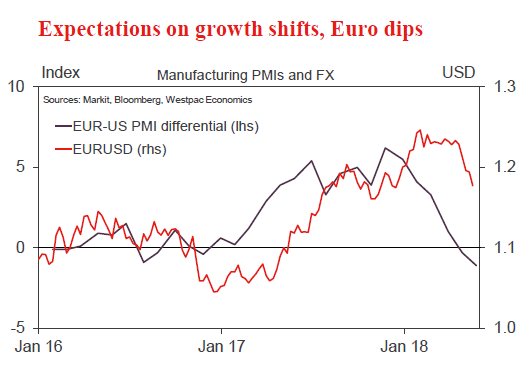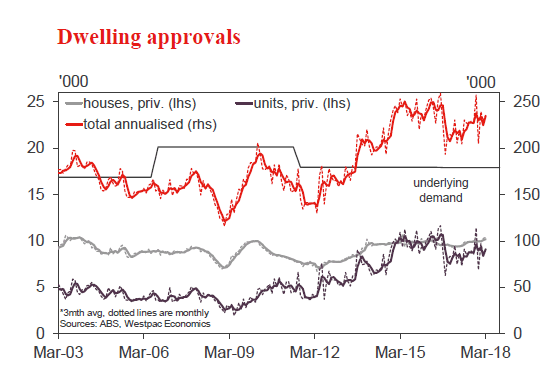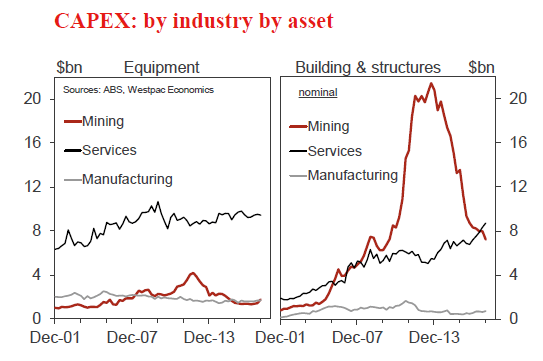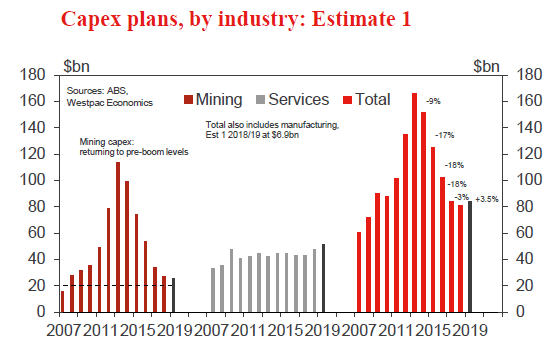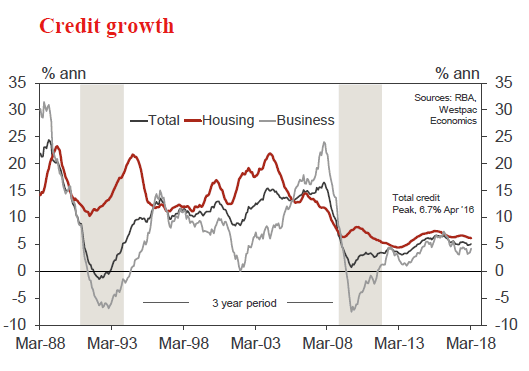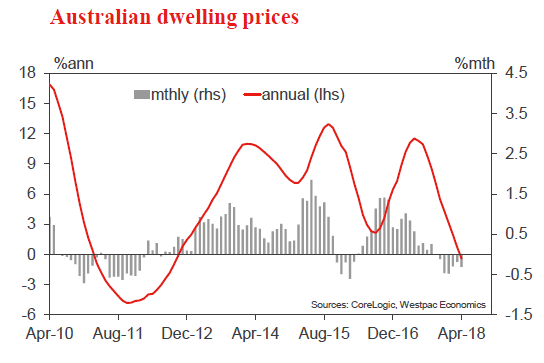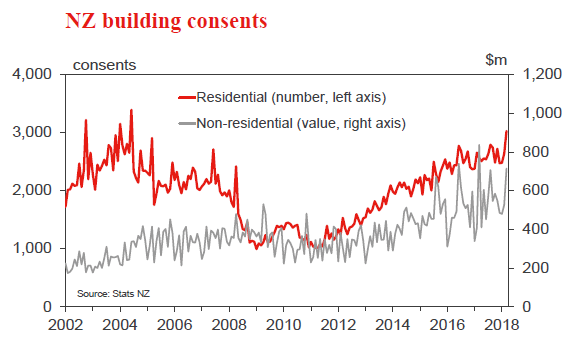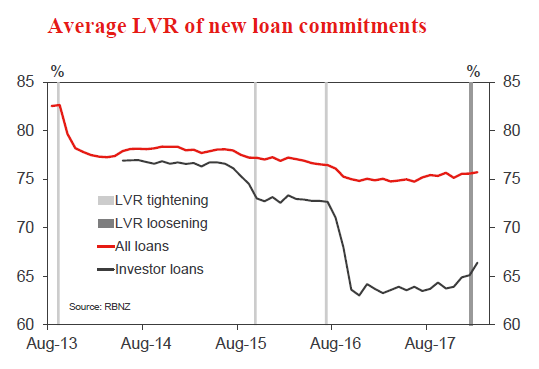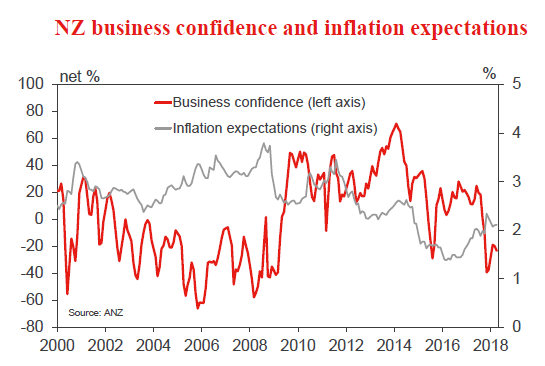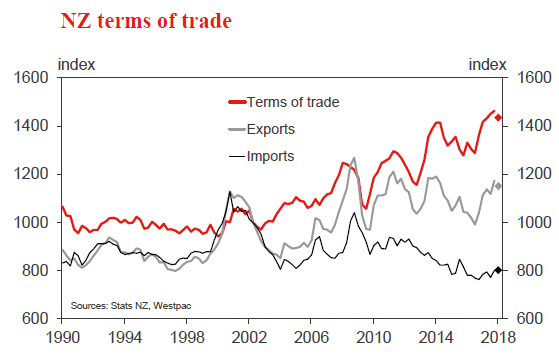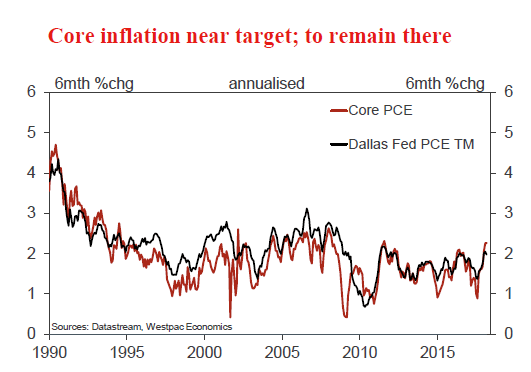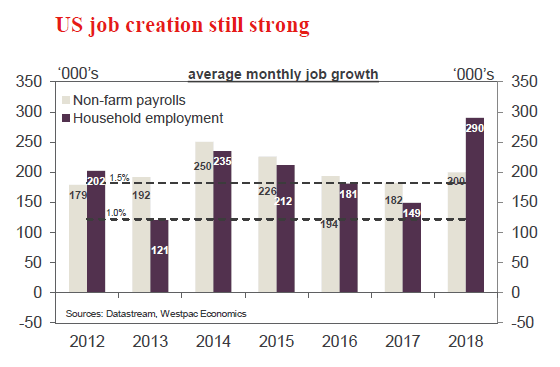Week beginning 28 May 2018
- Prospects for the Australian economy; markets; and global risks.
- Australia: business capex, CoreLogic home prices, dwelling approvals, private credit.
- NZ: RBNZ Financial Stability report, terms of trade, residential building consents, business confidence.
- Euro Area: CPI, unemployment, Bank of Italy Governor speaks.
- US: nonfarm payrolls, PCE deflator, Beige book, Memorial day.
- G7: finance ministers and central bankers meeting.
- Key economic & financial forecasts.
Information contained in this report current as at 25 May 2018.
Prospects for the Australian Economy; Markets; and Global Risks
As we contemplate the remainder of 2018 and 2019 there are a number of key themes that we believe will dominate economic and market developments. Our advice to customers throughout 2017 has been to expect Australia’s growth rate to likely be anchored below trend in both 2018 (2.7%) and slowing to 2.5% in 2019. That has contrasted with official forecasts (Reserve Bank and Treasury) which anticipate growth picking up to 3.25% in both 2018 and 2019.
We have recognised a solid ongoing boost to growth from non-residential construction; government investment (especially at the state level) and exports. However we are much more cautious than official forecasts on the consumer; residential construction and equipment investment.
Slowing household incomes
Signals from the December quarter national accounts are more encouraging for the official view. Household spending has been revised up from an expected 2.1% to 2.9% following the release of the December quarter national accounts. This picture of households has changed from “lacklustre” to “slightly below trend”.
However this was associated with a weak savings rate of 2.7% despite a boost in nominal labour income growth to 4.8% for the year largely due to an extraordinary lift in hours worked of 3.5%. With hours worked increasing so rapidly, labour income growth should have been boosted further but was constrained by wages growth and a drift to lower paid jobs – non-farm compensation per employee remained flat in the December quarter to be up an insipid 1.8% for the year.
Labour productivity fell over the year with GDP per hours worked falling by 1% over the year and unit labour costs growth lifting to 2%. This adverse development in labour productivity is tempering the recent strong demand for labour we experienced in 2017. In the four months to April the annualised employment growth rate has slowed to 1.3%.
There will clearly be a slowdown in the 2017 break neck pace of growth in hours worked over the course of 2018 and into 2019. Weak wages growth and the drift to lower income jobs looks set to continue putting downward pressure on growth in labour incomes. With the savings rate now probably at its lows, another year of below trend consumer spending growth can be expected.
Business investment
New business investment lifted by 5.8% over the past year, a sharp turnaround from a 6.2% decline over 2016. Over the year, infrastructure work fell 1.2%; non-residential building advanced 12.3% and equipment investment spending increased by 8.4%.
Mining equipment investment lifted by 31% over the year, reflecting the final fit out of three major projects. It is more encouraging that non-mining equipment investment lifted by 6.2% over the year following a slowdown in 2016 partly associated with the uncertainty around the 2016 election.
With another Federal Election due by May 2019 and even greater uncertainty associated with that election (conservative government was expected to win the 2016 election whereas the Labour opposition is ahead in the current opinion polls), we may start to see equipment investment run into some headwinds from that political uncertainty from the second half of 2018. A less upbeat outlook for consumer spending in 2018 and 2019 is also likely to discourage equipment investment.
Housing downturn
Dwelling investment contracted in 2017 by 5.8%. Based on the downturn in the trend in high rise approvals and a flat outlook for detached housing, we expect this downturn has further to run with the contraction accelerating into 2019. Oversupply and a marked slowdown in sales to foreigners are weighing on the outlook for residential building. House prices are now falling. On a six month annualised basis, prices are now falling in Sydney (-7.3%); Melbourne (-1.2%); Perth (-0.4%) and Brisbane (-0.1%).
The regulator’s macro prudential policies are restricting interest only loans and tighter guidelines for all new loans are slowing house prices and credit growth. In previous cycles the authorities have relied on raising interest rates to slow the highly cyclical housing market. This time, the same effect has been achieved by the regulator as banks have independently raised loan rates; foreign demand has slowed; and regulations have significantly squeezed the availability of credit. This process will continue for the foreseeable future and the supply of credit is expected to tighten markedly.
On the demand side the attractiveness of investment properties has diminished. Land taxes and lacklustre rental growth have tightened rental yields. Prospects of adverse tax changes in the event of a change of government are also impacting investor confidence. All major banks (with the exception of Westpac) are predicting rate increases out to end 2019. New lending to investors tumbled by 9% in April to be down 26% over the course of the last year.
The current fall in investor loans is comparable to the fall in 2015/2016. That subsequently reversed in the aftermath of the May and August rate cuts – prospects for a repeat of rate cuts seem unlikely.
We expect an extended period of falling house prices (up to 10% over the course of the next two years) with weakness particularly centred on the Sydney and Melbourne markets. This will represent a considerable change in the “atmospherics” around housing wealth and may weigh further on prospects for consumer spending.
While the wealth effect was modest in the period of rising house prices it is reasonable that there will be a more marked effect through the downswing.
Inflation below target
Inflation is also likely to remain benign holding a little below the bottom of the Reserve Bank’s 2-3% target band. In this regard we are in broad agreement with the Reserve Bank which is forecasting that underlying inflation will hold at around 2.0% in 2018 and 2019. Note that underlying inflation has held below the 2-3% target band in 2015; 2016 and 2017.
With underlying inflation likely to therefore register five consecutive years at or below the bottom of the target range it is reasonable to argue that Australia is experiencing a structural fall in inflation. Arguably, without the risk of overheating the housing market (as would have been a concern through 2016 and 2017), interest rates would have been even lower in Australia in recognition of this structural fall and the disappointing progress in restoring inflation to the target range.
Interest rate outlook
Throughout 2017 and 2018 we have been of the view that the official cash rate will remain on hold in both 2018 and 2019. With rates on hold in Australia and the US Federal Reserve continuing to raise rates, Australia’s cash rate has now fallen below the Federal funds rate. By end 2018, it is set to be 63 basis points below the Federal Funds Rate, and by end 2019, 112 basis points below the Federal Funds Rate.
Sustained period of negative Aus-US rate spreads
The US economy is operating with much less ‘slack’ in its labour market (unemployment rate of 3.9% compared to an estimated full employment rate of 4.5%) than Australia (unemployment rate of 5.6% compared to a full employment rate of 5.0%) but, to date, wage pressures have only recently emerged (six month annualised pace for the wages component of the ECI has lifted to 2.9%)
Of most concern to markets has been the planned lift in government spending ($300 billion over 18 months) and the Tax Cuts ($1.5 trillion over 10 years) in the US. These policies are likely to boost the Budget deficit by around 2% of GDP providing a solid boost to demand when the economy is already operating at full capacity in the labour market.
We expect two 25 basis point hikes in June and September from the FED. That would see the USD/AUD yield differential in the overnight market contract to minus 63 basis points – a situation we have not seen since early 2000. Two further FED hikes are expected in the first half of 2019.
AUD/USD Bond Spread
Back in August 2017, Westpac had been forecasting that AUD cash rates would fall below the US Federal Funds Rate by around 40 basis points by end 2018. That, in turn, would drive the 10 year bond spread to zero, from around 60 basis points. At that time markets were priced for the US fed funds rate to be around 35 basis points below Australia.
But now markets are expecting a yield differential of around minus 75 basis points by year’s end. We now expect RBA rates to be even lower than Federal Funds at minus 63 basis points by end 2018 and minus 112 basis points by mid-2019. The likely result is that AUD 10 year bonds will trade around 40 basis points below US bond rates by mid-2019.
Commodity Prices; China; and the Australian Dollar
Recent general euphoria around the global economic outlook has changed to caution. Uncertainty around trade; falling PMI’s in Europe; Japan and Korea and rising bond rates in the US all signal caution. Growth in the Chinese economy is expected to slow as consumption and net exports are unable to compensate for the ongoing slowdown in investment. However, the big uncertainties and risks centre around the Chinese financial system.
China realises that it must move away from its growth model based on credit fuelled exports and investment. In particular the role of the financial sector must change from channelling high savings at low cost to strategic sectors, to facilitating China’s economic transformation to a more sustainable model based on services and consumption. But the “old” model has resulted in financial assets growing from 260% of GDP in 2011 to 470% in 2016 (IMF, 2017). The excessive growth (around 30% per annum over the last 10 years) has been in the largely unregulated non- bank sector.
President Xi has nominated poverty; pollution and financial leverage as his key “challenges”. The “shadow banking sector” particularly funds property development and speculation; local governments (which explain 80% of infrastructure investment); and commodity speculators. All these users of funds expect excessive returns and can service higher loan payments . The sector is beginning to be squeezed.
We are already seeing some evidence of this squeeze on the non-bank sector. Banks are no longer allowed to guarantee wealth management products; entrusted loans (corporates borrowing to lend to other corporates with banks operating as agents) have been banned; rapid growth in short term interbank funding has been slowed; and general funding for wealth management products is being restricted. Growth in the nonbank sector is severely lagging the pace of 2017.
These forces are likely to weigh on iron ore and coking coal prices. Some lift in supply from Australian producers is also expected to lower prices. These atmospherics for commodity prices along with the widening interest rate differential; and more appetite for the USD in an uncertain world are eventually expected to weigh on the AUD. We target AUD at USD 0.74 by end 2018 and 0.70 by 2019.
The week that was
The past week has been short on data, but long on policy speak and politics. Other than to say that considerable uncertainty remains around the US/China trade relationship and geopolitical tensions with North Korea, herein we focus on the economics.
Of the commentary to hand, that from the FOMC is most notable. The minutes from their May meeting caught the market off guard, with the 10-year US yield falling from 3.06% ahead of the release to 2.98% the day after – the cancelation of the US/ North Korea summit was also a factor here. The surprise for markets (or at least those talking up inflation risks of late) was the calmness shown by the Committee. Rather than seeing the risk of a break higher in PCE inflation above 2.0%yr towards the CPI’s 2.5%yr current level, the Committee instead held that it was “premature to conclude that inflation would [even] remain at levels around 2 percent”. This view is seemingly based on “some of the recent increase in inflation” being representative of “transitory price changes” and as “various measures of underlying inflation, such as the 12-month trimmed mean PCE inflation rate from the Federal Reserve Bank of Dallas, remained relatively stable at levels below 2 percent”. To see upside inflation risks build, a stronger wage pulse is necessary. At present the employment cost index is only reporting “a gradual pickup in wage increases”, while the uptrend in other measures is “less clear”.
For those who doubt this view of inflation and instead anticipate it will sustain above 2.0%yr, the use of “symmetric” 10 times in the minutes cautions on the impact such an upside surprise would have on policy. Put simply, even if inflation does surprise to the upside and exceed 2.0%yr for a time, the Committee are likely to look through it, seeing such an episode as transitory and potentially needed to sure up long-term inflation expectations following such a long period of failure in achieving the target.
An acceleration in the pace of rate hikes would only be seen if inflation accelerated away from the FOMC’s medium-term target. The second important aspect of recent FOMC communications is their view of financial conditions and neutral. Broadly on financial conditions, these are seen as supportive of growth, with a US dollar well below its 2016 peak and equity markets near highs offsetting a return of the 10-year yield (and thus mortgage rates) back to their 2013 highs. The more significant point is that, now ‘neutral’ is nearing, the Committee is becoming more concerned over the potential for a non-linear response in financial conditions and/or growth from a rate hike(s). Whereas their longer-run expectation of the fed funds rate is 3.00% (from the March meeting forecasts), speeches made by regional Fed Presidents Harker, Kaplan and Bostic after the minutes release point to neutral currently being around 2.50-2.75%. President Williams of the San Francisco Fed (soon to be the NY Fed) update on R-star this week corroborated this view, seeing it stuck around 2.50%.
A perceived neutral rate of 2.50% and lingering doubts that inflation will run above the 2.0%yr target are supportive of our view that this FOMC hiking cycle will end after four further hikes in mid-2019 at 2.625% – well short of the FOMC’s seven hikes to the 2020 forecast, as per the March 2018 meeting forecasts. There is an additional element worth keeping in mind in all of this. The FOMC want to promote confidence in the economic and policy outlook. To do that, a positive sloped yield curve is strongly desired (to stop concerns of a recession developing). As such, expect short-term caution to be strongly emphasised by the FOMC, but those longer-term rate hike expectations to remain in place.
Moving back to Australia, this week we began the run to the March quarter GDP report (due Wednesday 6 June) with the construction work done release. The construction sector will offer a small positive contribution to growth in the quarter, spearheaded by activity in the public sector, particularly on transport projects. Private engineering work was broadly stable, as was new home building after it declined through 2017. Home renovations did bounce in the quarter, but the underlying trend remains subdued. By state, the south-east continues to lead the way; WA (unsurprisingly) lags.
Finally from our NZ economics team comes the latest quarterly outlook. In it they highlight that New Zealand’s growth cycle has now matured, with the sector mix shifting away from the consumer towards government spending. The terms of trade remains favourable for national income, though population growth is slowing. On monetary policy, the Westpac view remains that the RBNZ will stay on hold until the end of 2019 – a view that the market is increasingly warming to.
Chart of the week: Euro Area PMI
This week, the flash estimate for the Euro Area manufacturing PMI fell to 55.5 from 56.2 while the US manufacturing PMI edged up to 56.6 from 56.5.
The May release extended on April’s result which marked the first time the Euro Area PMI had been below the US PMI since late 2016 . Between then and now, the PMI differential and the EUR/ USD cross displayed a strong relationship, largely reflecting the past optimism over the Euro Area growth story. This has since subsided as growth slowed across the continent while political developments in Italy add further uncertainty.
New Zealand: week ahead & data wrap
New Zealand’s economy aging gracefully
New Zealand’s economic expansion has entered a more ‘mature’ phase. While GDP growth isn’t weak, it has slowed from the rates of 3.5% to 4% p.a. that we saw in recent years as earlier drivers of demand have cooled. And as we discuss in our latest Economic Overview1, we expect a further moderation over the next few years.
Among the more notable developments has been the slowing in migration led population growth. While net migration remains elevated, it has actually been easing back for around a year now. In fact, the net inflow of 67,000 people in the year to April was the lowest it’s been in two years. We expect that net migration will continue to slow as many of those who arrived in recent years on temporary visas depart.
At the same time, the heat has come out of the housing market. After a brief resurgence, house prices have started to fall again in Auckland and Christchurch, and the pace of increase has slowed sharply in Wellington. With a range of significant government policy changes targeting the housing market being introduced (such as the extension of the ‘bright line’ test for taxing capital gains which came into effect at the end of March), we expect house prices will lose further ground over the remainder of this year.
The slowdown in the housing market will dampen households’ spending appetites. In fact, we’ve already seen softness in the retail sector in the early part of 2018: core retail spending only rose by 0.6% in the March quarter, and electronic card transactions for April point to a soft path for spending.
With the housing market cooling, we could see the RBNZ easing lending restrictions again later this year. We’ll be watching the upcoming May Financial Stability Report (due for release at 9.00am on Wednesday 30 May) to see how the RBNZ’s thinking in this area is evolving.
Finally, as we discuss below, the construction sector is also taking a breather, with activity set to rise only gradually despite strong demand.
Helping to offset the above headwinds are some positive factors. Along with low interest rates, the terms of trade are strong and government spending is stimulatory. This mixture suggests the economic expansion will age gracefully rather than expire suddenly, with GDP growth of a little below 3% p.a. expected over the next few years.
We expect headline inflation will push higher over the coming year and will briefly reach the 2% mid-point of the RBNZ’s target band. That could cause the RBNZ to become a little more hawkish later this year. However, the near-term lift in inflation that is occurring is a result of the recent drop in the NZ dollar and the sharp rise in oil prices. Those factors are only providing a temporary boost to inflation. Under the surface, the factors that have contributed to New Zealand’s ‘lowflation’ environment have not gone away. As a result, core inflation is likely to remain below the RBNZ’s 2% target band for some time. Consequently, we still expect that the OCR will only begin rising at the end of 2019, and we are pleased to see that financial markets have largely come around to that view.
Can we build? Yeah…Nah.
There’s been a lot of debate recently around how much residential construction we’ll see over the next few years, and what role the Government’s flagship KiwiBuild program will play. KiwiBuild aims to provide funding to support the construction of 100,000 affordable homes over the next decade. In the May Budget, the Treasury changed some of its assumptions regarding how this would play out, and it now forecasts that the boost to construction will occur later than they had previously assumed. In fact, their forecast for the additional nominal residential investment that KiwiBuild will generate by 2022 is now around half of what they forecast back in December, with the bulk of activity expected to occur beyond that date. This forecast change stemmed from updates in the assumed timing of capital expenditure on KiwiBuild. In addition, the Treasury has continued to stress that capacity constraints mean that KiwiBuild spending and private demand could crowd each other out. That means that the overall increase in total home building will be smaller than the number of KiwiBuild homes implies.
In contrast, the Ministry of Business, Innovation and Employment (MBIE) expects a much faster lift in KiwiBuild related building. In fact, a recent MBIE report suggest that between 2018 and 2022 additions to residential building as a result of KiwiBuild could be around two to four times as large as the Treasury assumed in the May Budget. MBIE’s report highlights a range of financial constraints that KiwiBuild funding could help alleviate to support building.
Crucially, however, MBIE’s report noted that: “our estimates did not discount for capacity constraints or substitution.” To put that differently, MBIE’s forecasts provide an indication of how many homes might be built under the KiwiBuild banner. But they don’t really give us an indication of what the overall level of construction activity will look like, or how much private sector activity KiwiBuild might displace. In contrast, the softer forecasts from the Treasury explicitly allow for such constraints, and assume that they will be even more of a drag on home building over the next few years.
Capacity constraints are really what is at the heart of the outlook for construction. After large increases in recent years, the sector is encountering some strong headwinds, including rising costs and shortages of skilled labour. That means the KiwiBuild program will be one more buyer in an already constrained market. Even allowing for an increase in the size of the labour force over the coming years and a shift to smaller, higher density homes, the building sector is going to be wrestling with constrained capacity for some time yet. This means that, even if KiwiBuild related construction does pick up (and we have our doubts), this would likely result in private sector construction being crowded out.
We expect that KiwiBuild will help to offset some of the financial headwinds in the construction sector over the next few years. And longer term, KiwiBuild related efforts to increase construction sector capacity could also increase building activity. Nevertheless, it will be a slow grind higher, and more gradual than even the Treasury’s forecasts assume.
Data Previews
Aus Apr dwelling approvals
- May 30, Last: 2.6%, WBC f/c: -3.0%
- Mkt f/c: -3.0%, Range: -7.0% to 7.3%
Dwelling approvals firmed in March, rising 2.6% to be up 14.5%yr (albeit with the annual gain exaggerated by monthly volatility affecting the base period). The March rise was led by a solid +6.1% rebound in units, led by high rise, and a reasonably firm 1.1%mth gain for private detached houses.
Lead indicators continue to point to softening approvals in the months ahead. As we have highlighted for some time, a sharp fall in site purchases last year suggests the pipeline of new high rise projects is set to take another leg lower. Meanwhile, a fall off in construction-related housing finance approvals – which had firmed through the six months to March – is also pointing to a move lower for non high rise approvals. Neither of these indicators are precise enough to pin point the often large monthly swings in approvals. Nonetheless the weakening theme is clear. On balance we expect approvals to retrace 3% in the April month, risks as always centring on the volatile high rise segment.
Aus Q1 business capex
- May 31, Last: -0.2%, WBC f/c: -0.8%
- Mkt f/c: 1.0%, Range: -1.0% to 3.0%
Business capex spending turned the corner in 2017 with the mining investment wind-down largely complete and with the emergence of an upswing in investment by the non-mining economy. Capex rose 4% in 2017 after four years of decline.
Despite this, we anticipate a small pull-back in Q1, forecasting a decline of 0.8%.
Building & structures capex is expected to fall by almost 1.5%. Building activity surprisingly fell, a reported -4.2% (Construction survey), which is likely to be promptly reversed given the strength of approvals. Infrastructure activity edged higher, +0.4% (Construction survey).
Equipment spending is expected to consolidate, with a flat result. This follows a Q4 outcome of 2.2%qtr, 7.2%y, including a 23% jump for mining, likely boosted by the fit out of major projects nearing completion. The risk is that mining equipment spend pulls back in Q1.
Aus capex plans
- May 31, Last (Est 1 for 2018/19): $84.0bn, +3.5%
This survey, conducted during April and May, includes the 2nd estimate of capex spending plans for 2018/19. A word of caution, estimates 1 and 2 can be unreliable.
In the previous survey, Est 1 for 2018/19 was $84bn, some 3.5% above Est 1 a year ago. This is the first positive ‘Est 1 on Est 1’ comparison since 2012/13.
For mining, Est 1 on Est 1 is only a modest negative, at -5%, with the investment wind-down nearing its end.
For services, Est 1 vs Est 1 is +8%, evidence that the investment upswing is set to continue, with strength in buildings reflecting the lift in commercial building activity.
This update is likely to confirm the broad themes evident in the capex survey 3 months earlier.
Potentially, Est 2 will be around $90bn, a 7% upgrade on Est 1, which would have Est 2 on Est 2 at +4%.
Aus Apr private credit
- May 31, Last: 0.5%, WBC f/c: 0.4%
- Mkt f/c: 0.4%, Range: 0.3% to 0.6%
Private sector credit is expanding at a modest pace as the housing sector cools. In 2017, credit grew by 4.9%, slowing from 5.6% for 2016.
For April, we expect a rise of 0.4%, in line with the recent average but a tick down on the March outcome of 0.5%.
Housing credit, at this late stage of the cycle, is slowing in response to tighter lending conditions. In March, housing credit expanded by 0.45%, which is a 5.6% annualised pace, well down from the 6.8% annualised pace of last May.
Business credit, 4.2% above the level of a year ago, is volatile around a modest uptrend as businesses increase investment in the real economy. The segment hit a soft spot at the turn of the year, up only 0.1% in the 3 months to February. This was followed by a 0.8% jump in March, suggesting that the upward trend has resumed.
Aus May CoreLogic home value index
- Jun 1, Last: -0.3%, WBC f/c: -0.2%
The CoreLogic home value index, covering the eight major capital cities, dipped 0.3% in April marking the sixth successive monthly decline. Prices nationally are down 0.3%yr, the first annual fall since Oct 2012. The most disaggregated price data shows about a third of properties nationally are experiencing annual price declines – a more widespread correction than in 2015-16 but a much lower incidence than seen during the bigger price corrections in 2011-12, 2008-09, the mid 2000s and the mid-1990s.
The daily index points to further 0.1% decline in May that will take the annual rate of decline to -1.1%yr nationally. Auction clearance rates have tracked lower in recent months and are now marginally below long run averages in both Sydney and Melbourne.
NZ Apr residential building consents
May 30, Last: 14.7%, WBC f/c: -10%
- Residential building consents surged higher in March. This was underpinned by a sharp rise in multiple consents (such as apartment buildings) in Auckland and elsewhere.
- Multiple consents tend to be lumpy on a month-to-month basis, and we expect to see a reversal in April. That would pull overall consent issuance down by 10%.
- Smoothing through the volatility associated with multiple consents, construction activity has flattened off in recent months. Construction firms are highlighting shortages of skilled labour and difficulties with financing as important brakes on the pace of building.
NZ RBNZ Financial Stability Report
May 30
- The RBNZ’s six-monthly review of the financial system provides a window of opportunity to review the loan-to- value restrictions on mortgage lending. Last November the RBNZ eased the LVR restrictions, albeit only slightly, and indicated the criteria for a further easing. House price and credit growth would need to slow to more sustainable rates, and the RBNZ would need to be satisfied that an easing wouldn’t lead to a resurgence in the housing market.
- House price inflation is running at or below household income growth, and credit growth has slowed. A range of new Government policies aimed at cooling the housing market are in progress.
- Our forecasts assume some further easing of the LVR restrictions over this year. It’s quite possible that the RBNZ will move as early as this month, even if it’s just an incremental move along the way.
NZ May ANZ business confidence
May 31, Last: -23.4
- Business confidence fell in April, led by a weaker outlook by firms in the construction sector
- The extent of the deterioration in confidence in construction was surprising given the Government’s promotion of its Kiwibuild programme and significant housing shortages in the Auckland region. However, it is consistent with other indicators, such as consents, which suggest a lull in building activity in the coming months. It will be interesting to see if the pessimistic outlook of construction firms was maintained in May.
- Inflation expectations were little changed last month despite CPI falling sharply in Q1.
NZ Q1 terms of trade
- Jun 1, Last: 0.8%, WBC f/c: -2.0%, Mkt f/c: x%
The terms of trade reached a new all-time high in 2017. Export commodity prices have held up well, while prices for imported manufactured goods have been trending lower for some time.
We expect the terms of trade to start the new year with a 2% decline, led by a fall in export prices. Prices for dairy, meat and wool were all lower in the March quarter, though we think these declines will be temporary.
We expect import prices to be flat for the quarter. Oil prices rose, but manufactured goods prices are likely to have fallen further, helped by a stronger exchange rate.
US Apr PCE report
- May 31, personal income, last 0.3%, WBC 0.3%
- May 31, personal spending, last 0.4%, WBC 0.5%
- May 31, core deflator, last 1.9%yr, WBC 1.8%yr
Indicators of wage inflation have been mixed of late, with a clear uptrend yet to be established. We expect some firming over the coming year, but for the employment cost index and other measures to only stabilise around 3.0%yr.
A lack of a material uplift in wages growth and a low savings rate mean that the US consumer is likely to remain constrained. Solid retail sales in the month and further support from services should bring about a decent outcome.
Inflation remains a focus for all in markets. In contrast to the headline CPI at 2.5%yr, measures of PCE inflation remain at or below the 2.0%yr medium-term target. The FOMC expect this trend to persist, and consequently have shown caution towards the pace and extent of rate hikes from here.
US May employment report
- Jun 1, nonfarm payrolls, last 164k, WBC 180k
- Jun 1, unemployment rate, last 3.9%, WBC 3.9%
Employment growth remains strong in the US, the yearto- date average being ahead of 2017 and materially above population growth. In coming months, a slight softening is anticipated, bringing 2018 into line with 2017 and 2016.
Still well ahead of population growth, this outcome will see the unemployment rate push lower in coming months from the already historically low 3.9% of April. Importantly, underemployment is also continuing to trend lower, signalling a further taking up of slack in the labour market.
A key reason why this decline in labour market slack has not translated into higher wages growth is because prime-aged individuals outside the labour market continue to return. This is expected to persist over the coming year.




